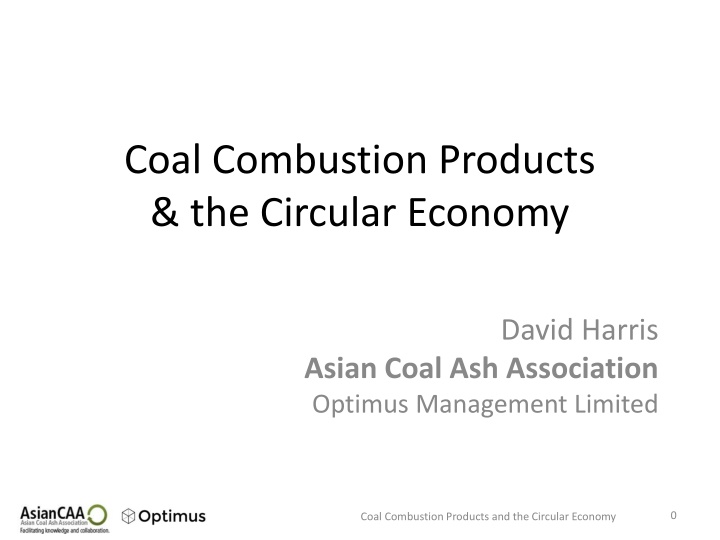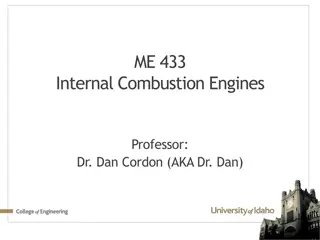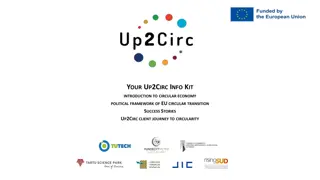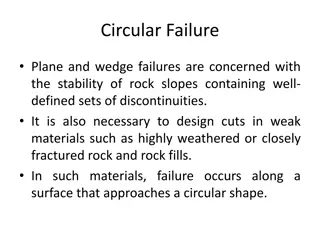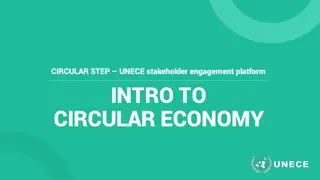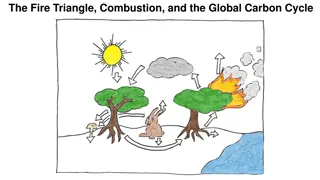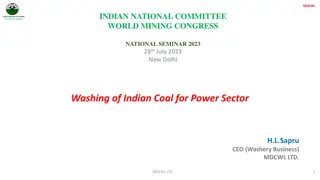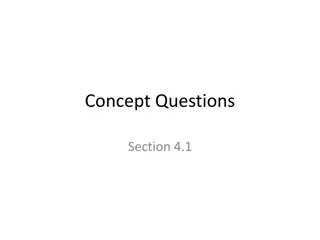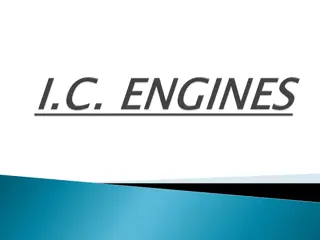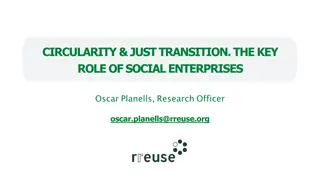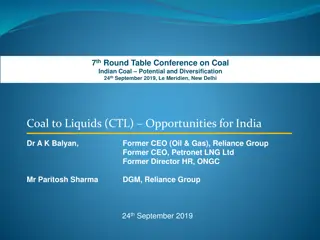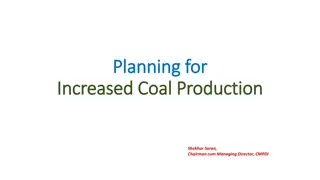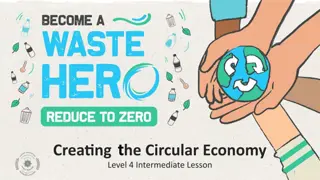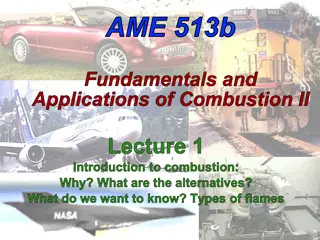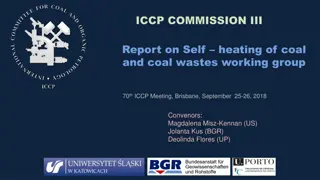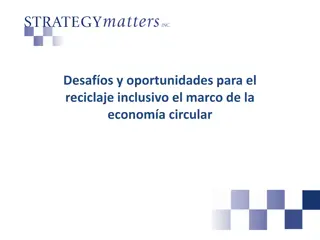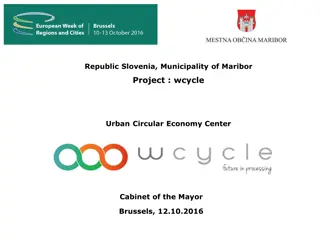Coal Combustion Products & the Circular Economy - Addressing Resource Flow Challenges
This discussion delves into the intersection of coal combustion products and the circular economy, emphasizing the need for continuous re-evaluation of resource chains, ecosystem metabolisms, and industrial innovations to ensure sustainable environmental practices and economic growth. Exploring the opportunities and limitations, it highlights global resource consumption trends, China's leadership in promoting a circular economy, and the significant role of circular economy principles in China's industrial policies since the early 2000s.
Download Presentation

Please find below an Image/Link to download the presentation.
The content on the website is provided AS IS for your information and personal use only. It may not be sold, licensed, or shared on other websites without obtaining consent from the author.If you encounter any issues during the download, it is possible that the publisher has removed the file from their server.
You are allowed to download the files provided on this website for personal or commercial use, subject to the condition that they are used lawfully. All files are the property of their respective owners.
The content on the website is provided AS IS for your information and personal use only. It may not be sold, licensed, or shared on other websites without obtaining consent from the author.
E N D
Presentation Transcript
Coal Combustion Products & the Circular Economy David Harris Asian Coal Ash Association Optimus Management Limited 0 Coal Combustion Products and the Circular Economy
The Circular Economy Continuous re-evaluation of already extracted resource chains Current ecosystem metabolisms lead to overabundance of flows. Imitate natural cycles as closely as possible Rethinking value unlocking synergies comprehensive accounting Circular Economy: Finding new pockets of growth within sustainable environmental boundaries. Coal Combustion Products and the Circular Economy 1
Scope/Limitations Coal Combustion Products Material flows Eco-Industrial Parks Industrial synergies and new technologies China India This talk focuses on: Important (but under- represented herein): Energy, Water, Socio-economic aspects of CE Measurement (eg. Material Circularity Index) Design of materials and products to flow in effective cycles Other regions Nomenclature (CCP s, CCR s, Anthropogenic Minerals, Post- Combustion Minerals, etc.) Other concepts? Coal Combustion Products and the Circular Economy 2
Global resource consumption: Reaching crisis levels Europe 28 (2012) China (2014) Waste Generated (Industrial Solid Waste) 2.5 Billion mT 3.2 Billion mT Waste Recovered (Recycling, composting, incineration or reuse) 1.0 Billion mT 2.0 Billion mT Net Surplus 1.5 Billion mT 1.2 Billion mT Population 0.5 Billion 1.5 Billion Net Waste Intensity 3mT/person 0.8mT/person Coal Combustion Products and the Circular Economy 3
Chinas Leadership: Circular Economy & Stability China has also seen an increasing number of protests by local residents over environemntal problems (chemical plants, waste-incineration projects, etc) in recent years. Social Stability Risks could soar as China becomes more dependent on imported resources from unstable parts of the world. Geopolitical Fuels and minerals accounted for 30% of the total cost of China's imports in 2012, compared with just over 5% in 1990. Economic Coal Combustion Products and the Circular Economy 4
Brief History of CE in China 1990 s 2002 2008 China followed Germany & Japan in adopting circular economy concept Circular economy formally legislated as national endeavour 16thPeople s Congress (Oct. 2002) Formalized CE concept in Circular Economy Promotion Law Any new industrial policies created by the Government must meet the criteria for promoting a circular economy. Industries must implement management systems that reduce resource usage and waste generation, while improving resource recovery and recycling. 2013 to Present World leaders in cleantech investment and promotion of waste material recirculation: Setting clear targets Adopting policies and financial measures: Circular Economy Development Strategies Action Plan (2013) Outlines targets meant to address both industrial and social sectors. 2017 - 19thPeople s Congress (Oct. 2017) Developing more policy, enacting further legislation Coal Combustion Products and the Circular Economy 5
Stated Circular Economy Goals 2015 goals: Having a widely used resource recycling technology that is advanced, re-using 72% of industrial solid waste a modern system for recovering at least 70% of waste products improving the recovery of important resources. raising energy productivity by 18.5% increasing water productivity by 43% aiding the recycling industry to reach US $276 billion of output re-using 70% of some minerals that are heavy pollutants. 2020 goals Having an innovative industrial technological system that can efficiently re-use and recycle material creation of a new industry related to the manufacturing of innovative technical equipment that promotes competitive advantages. The advanced industrial technological systems should be able to address the waste management concerns of rural and urban areas by 2020. Coal Combustion Products and the Circular Economy 6
Levels of circular economies Societal level initiatives Development of Eco-cities and Eco-provinces Aims to address social concerns with both production and consumption of products that pollute. Macro Inter-firm initiatives Eco-industrial parks (EIPs), where industrial plants are constructed in close proximity and capitalize on the trading of industrial by-products, ultimately reducing waste. Meso Corporate level implementation Refers to initiatives related to the Eco-design of manufacturing plants, such as cleaner production and Environmental Management Systems (EMS) that are meant to reduce the production of harmful by-products. Micro Coal Combustion Products and the Circular Economy 7
Key Mechanism: Eco-Industrial Park Collaborative strategies include: by-product synergy ( waste-to-feed exchanges) wastewater cascading shared logistics, shipping & receiving facilities shared parking green technology purchasing blocks multi-partner green building retrofit district energy systems local education & resource centres. Systems approach designs and processes/activities are integrated to address multiple objectives. Eco-Industrial Park A community of manufacturing and service businesses, located together on a common property where members seek enhanced environmental, economic, and social performance through collaboration in managing environmental and resource issues. -The Eco-industrial Park Handbook Coal Combustion Products and the Circular Economy 8
Kalundborg Eco-Industrial Park One of the best known examples of industrial ecology. Inspiration for China EIP s 7 key partners CO2 reduction 275,000 tpa 20-60 million euros pa Payback on capital in ~7 years CHINA SCALE Suzhou Industrial Park 288 square kilometers 25,000 companies 91 Fortune 500 companies GDP of ~US$35 Billion From eco-park to eco-city Coal Combustion Products and the Circular Economy 9
Scale: Chinas State Directed CCP Ecosystem Governmental Bodies Coal Power Producers Influential quasi- governmental bodies National Ministry of Industry and Information Technology Ministry of Housing and Urban-Rural Development Datang Huaneng Development and Reform Commission Huadian CPI Ministry of Science and Technology Ministry of Environment Protection China Association of Resources Comprehensive Utilization China Association of Circular Economy Ministry of Commerce Ministry of Finance Guodian Other IPPs China Building Materials Federation Provincial Government Municipal Government Construction Material Producers and Buyers Constructional material Building product mfr s Architects LDI s Construction firms Key Institutional Stakeholders Research institutes China Coal Processing and Utilization Association Fly Ash Research Center, Dezhou Colleague International organisations Industry and finance Department of Foreign Affairs and Trade National Trade Commission Chambers of Commerce Solid Waste Utilization Technology Research Center Other local and international companies as potential partners or investors China Ashtech Development Center Greentech Initiative Greenpeace 10
Coal Plant: Points for CE Optimisation Coal Supply Coal Additives Coal Mill Boiler Increase burn efficiency Decrease NOx, SOx Improve by-products Higher grade coal Coal washing Coal blending Finer milling Mill efficiency Air flow Efficiency Waste heat use FGD System Precipitators Steam Water Efficiency Material quality for use downstream Efficiency Segregation of size fractions Waste steam use Efficiency Recycling Stack Storage PM, NOx/SOx capture Carbon capture and utilisation Segregation of materials In-line classification Design for recovery Coal Combustion Products and the Circular Economy 11
Geotechnical binders FGD Agriculture Adsorption Agent Zeolite Production Soil amendment Fertilizer Gypsum Board FGD Adsorbant Fly Ash Gypsum board Fly Ash For CSA cements Waste steam Coal Fired Power Station Wastewater Wastewater Treatment Fly ash classification and milling Fly Ash Concrete Fly Ash Coal Cleaning Carbon fuel Readymix Cement Plant & Concrete products Magnetite Activated Carbon Carbon Tiles Refractories Alumina Extraction Industrial Ceramics Aluminosilicate s Construction Industries Cenospheres Paint and Coatings Aluminium Production Rubber Plastic 12 Coal Combustion Products and the Circular Economy CCP Eco-Industrial Park Concept 12
Geotechnical binders Agriculture Fertilizer (Eg. Gypsoil) Soil amendment (Eg. Inner Mongolia) CCP Technology Innovations Soil amendment (Eg. Ekotech) Fly Ash For CSA cements (Eg. UKCAER) Waste steam (Eg. Alpa) Coal Fired Power Station Fly ash classification and milling Fly Ash Enriched coal (Eg. SCTech) Concrete Alkali Activated Concrete Fly Ash Coal Supply GBFS Cement Plant Cement Kiln Dust (or other secondary CaO source) Steel Plant Tiles Refractories Industrial Ceramics (Eg. Vecor) Alumina Extraction Mineral Separation Construction Industries Eg. Datang Aluminum Paint and Rubber Plastic Coal Combustion Products and the Circular Economy Coatings 13
SCTech: Boiler as Cement Kiln Less virgin CaCO3 for flue gas desulfurization (from limestone quarry) Cement/Lime Kiln Dust or CaO (Ash upgrade & desulfurization) Weigh in feeder Boiler/ Kiln SCR Coal Supply Electrostatic Precipitators Air Mill Heater Stack FGD Bottom Ash Reactive Fly Ash Mixed with proprietary activator to produce zero-carbon cement Benefits of SCTech Cement System 3 x durability vs OPC (LCA) 50% water demand Zero carbon (vs 850kg/ton of OPC) FGD Slurry Treatment and Dewatering Less FGD Byproduct Coal Combustion Products and the Circular Economy 14
Mineral Composition of SCTech ash Base Fly Ash Calcium Enhanced Fly Ash % % Wollastonite Wollastonite 0.6 1 Krotite Krotite 1.2 0 Albite Albite 1.7 1.8 Hematite Hematite 3.7 1.8 Lime Lime 5.9 17.6 Corundum Corundum 14.8 13.7 Quartz Quartz 29.3 16 Mullite Mullite 42.7 48.1 Coal Combustion Products and the Circular Economy 15
Designing CCP Eco-industrial Park Stage 1: Technical/Operational Overview 1) Plant technical information 2) Current production analysis 3) Regulatory analysis a. Specifications of each individual boiler b. Ash production volumes by boiler c. Schematic of ash collection and storage systems d. Coal resource information a. Fly ash chemical and physical composition analysis i. Samples to be sent to affiliated labs for testing and interpretation b. Fly ash production, collection, storage and processing analysis a. Material handling requirements b. Transportation restrictions/requirements c. Storage restrictions/requirements d. Building material standards 4) Logistics infrastructure appraisal, storage and loading/unloading via: 5) Export opportunity analysis 6) Technically viable value added opportunities a. Run of station ash b. Fine ash (classified ash) c. Beneficiated ash products a. Preliminary technical viability assessment: i. ash analysis ii. logistics infrastructure iii. regulatory analysis a. Truck b. Rail c. Port Coal Combustion Products and the Circular Economy 16
Designing CCP Eco-industrial Park Stage 2: Commercial/Technical Feasibility 1) Financial overview 2) Resource overview 3) Industrial ecosystem analysis a. Capital requirements/availability b. Financial performance targets a. Land requirements/availability b. Equipment inputs c. Raw material inputs d. Skilled labor a. Other local producers or users whose products or by- products (waste streams) may have synergy with prospective technologies. 4) Addressable market analysis a. Study of addressable markets (domestic and export) for specific products/price points. b. Get real market feedback from potential customers, samples, trial orders, etc. 5) Shortlist of technologies/opportunities that correlate with parameters Coal Combustion Products and the Circular Economy 17
Barriers to CE adoption Motivating producers and downstream industries to support the circular economy Financial Regulatory Supporting materials management and monitoring Improving commodity markets for secondary raw materials Markets Data & information systems Models and algorithms Information Knowledge Best practice and skills exchange Coal Combustion Products and the Circular Economy 18
New Frontier: India Supply CCP s to reach between 150 million and 900 million tpa by 2040 Demand Indian construction sector poised to become 3rd largest globally. Already > 8% of GDP, construction accounts for about 20% of total material demand. Affordable housing shortage to reach 38 million units by 2030. To meet needs of rapidly urbanising population, India must build 700-900 million square metres of new commercial and residential space every year. Challenges Highly fragmented, largely informal construction sector Underdeveloped downstream industries (Readymix concrete uses <1% of fly ash produced in India) Administrative barriers and red-tape Coal Combustion Products and the Circular Economy 19
India CCP and CE: Opportunity Government initiatives suggest that the time is ripe for Indian cities to embrace circular economy approaches. Accelerating investment in construction of urban infrastructure: Smart Cities Mission Development of industrial corridors Swachh Bharat Mission City renewal schemes eg. 500 AMRUT cities Government initiatives US$ 1.2 trillion Research by the McKinsey Global Institute indicates that India needs to invest 77 lakh crore (US$ 1.2 trillion) in city infrastructure by 2030. New materials that offer economic advantages can support the provision of affordable housing, while reducing the environmental impact of extracting and processing materials, such as sand and aggregates. Coal Combustion Products and the Circular Economy 20
Coal Combustion Products, Infrastructure & the Circular Economy Developing infrastructure following circular economy principles can avoid getting locked into resource-ineffective systems in the long term. As new building technologies and business models emerge and reach scale, urban and infrastructure planning should embrace circular economy approaches. Circular economy opportunities will help China, India and other nations create high-quality spaces where people would live, work, and thrive. Coal Combustion Products and the Circular Economy 21
Thank You. Questions and comments very welcome! www.asiancoalash.org www.optimusml.com www.coalashsolutions.com David Harris d.harris@asiancoalash.org d.harris@optimusml.com Coal Combustion Products and the Circular Economy 22
